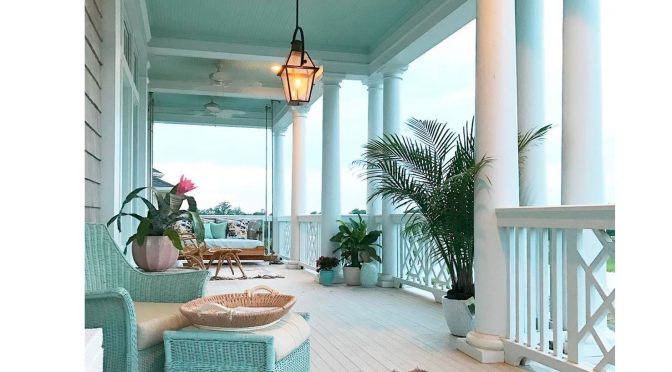While your customers are accustomed to carefully choosing the color of paint used on the four walls of a room, the ceiling is often overlooked. You can help them create visual interest with little effort by getting creative with your ceiling color recommendations.
Painting a ceiling adds dimension by drawing your eye upward. By changing the color of your ceiling from standard white to a medium or deep color, you can add warmth and richness to a room.
Blue skies, nothing but blue skies
In the Northwestern United States, aurora blue is a popular shade for the porch ceiling. It was originally associated with the Aurora Colony, a 19th century Christian communal society.
Blue porch ceilings are also prevalent in historic East Coast cities like Boston and Philadelphia, where Victorian and Colonial style homes are popular.
Sky blue ceilings were a popular color for the Victorians, who preferred the colors of nature when painting their homes. Mustard yellow, ochres, browns, olives, terra cotta and the color blue were commonly used in exterior paint schemes.
The warm earth tones reminded the Victorians of the outdoors, with the blue reserved for the porch ceiling to remind them of a sunny sky even when the days were overcast and gray.
The Haint Blue tradition
Blue and blue-green ceilings have also been popular in the Southern United States for centuries.
The tradition dates back to the Gullah people, descendants of African slaves who worked on Southern plantations. They feared restless spirits called haints which they believed to be trapped between the worlds of the living and the dead.
The color Haint Blue was then applied to porch ceilings, shutters and window and door trims of homes in the south to ward off these evil spirits.
Tricking nature?
Some thought the color fooled the spirits into passing through the porch roof up into the sky where they belong. Others believed that haints were unable to cross over or through water. Haint Blue paint on window and door trim or shutters would therefore discourage spirits from entering the home.
Then there are others who swear that insects and birds perceive Haint Blue ceilings as the sky and don’t try to nest on them. This actually may have had more to do with the composition than the color of the paint. Research shows that when blue paints were first used on ceilings, they were usually milk paints, which often had lye mixed into the composition. Lye is a known insect repellent.
No matter what the scientific truth, there’s no arguing that a blue ceiling, inside or out, adds a cool and pleasant splash of color to a room. It’s just one of many ways you can brighten up your customers’ fifth wall.
This article was originally published in the Winter 2014 issue of PPC magazine. Learn more about using color to win jobs and better serve your customers at the Sherwin-Williams contractor website.

